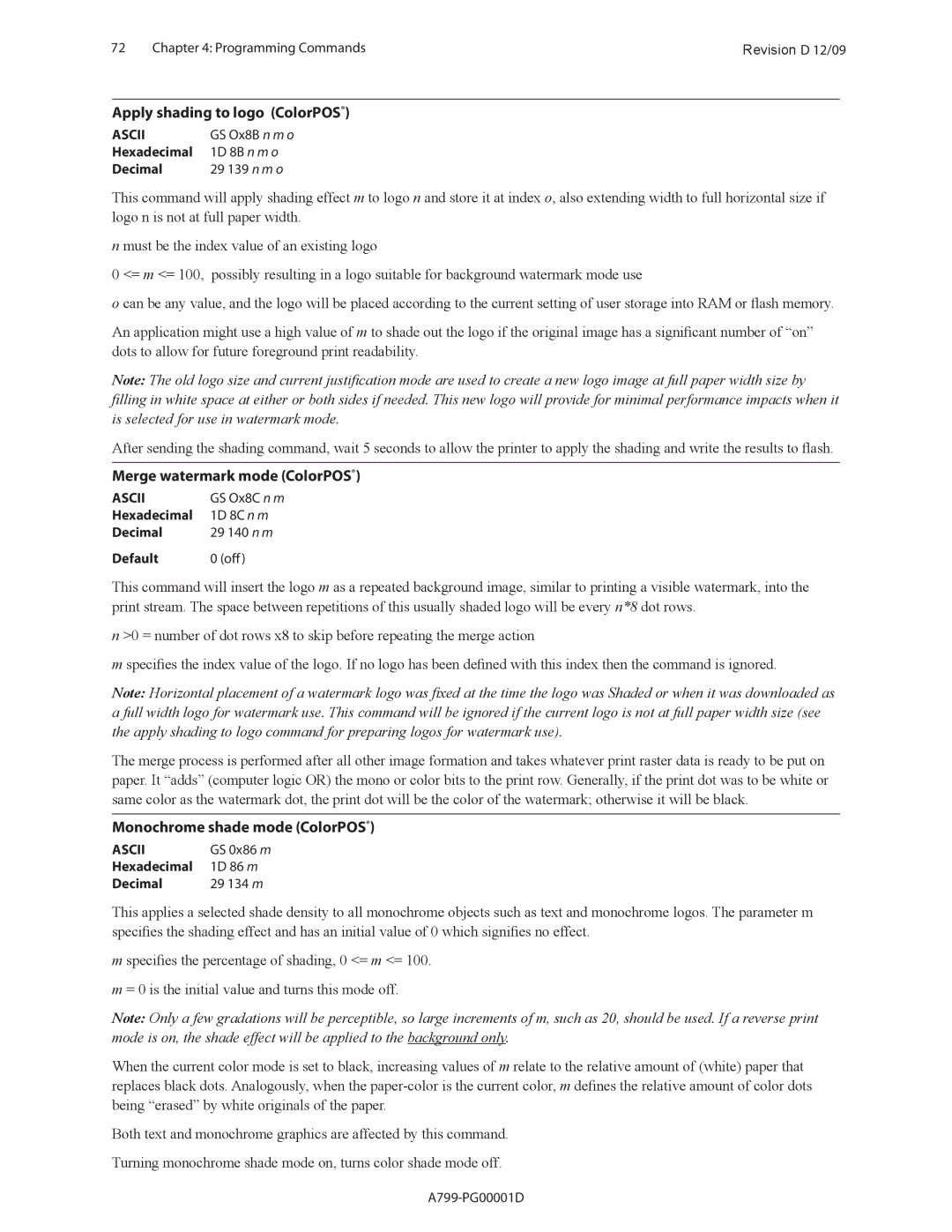
72 | Chapter 4: Programming Commands | Revision D 12/09 |
Apply shading to logo (ColorPOS®)
ASCII | GS Ox8B n m o |
Hexadecimal | 1D 8B n m o |
Decimal | 29 139 n m o |
This command will apply shading effect m to logo n and store it at index o, also extending width to full horizontal size if logo n is not at full paper width.
n must be the index value of an existing logo
0 <= m <= 100, possibly resulting in a logo suitable for background watermark mode use
o can be any value, and the logo will be placed according to the current setting of user storage into RAM or flash memory.
An application might use a high value of m to shade out the logo if the original image has a significant number of “on” dots to allow for future foreground print readability.
Note: The old logo size and current justification mode are used to create a new logo image at full paper width size by filling in white space at either or both sides if needed. This new logo will provide for minimal performance impacts when it is selected for use in watermark mode.
After sending the shading command, wait 5 seconds to allow the printer to apply the shading and write the results to flash.
Merge watermark mode (ColorPOS®)
ASCII | GS Ox8C n m |
Hexadecimal | 1D 8C n m |
Decimal | 29 140 n m |
Default | 0 (off) |
This command will insert the logo m as a repeated background image, similar to printing a visible watermark, into the print stream. The space between repetitions of this usually shaded logo will be every n*8 dot rows.
n >0 = number of dot rows x8 to skip before repeating the merge action
m specifies the index value of the logo. If no logo has been defined with this index then the command is ignored.
Note: Horizontal placement of a watermark logo was fixed at the time the logo was Shaded or when it was downloaded as a full width logo for watermark use. This command will be ignored if the current logo is not at full paper width size (see the apply shading to logo command for preparing logos for watermark use).
The merge process is performed after all other image formation and takes whatever print raster data is ready to be put on paper. It “adds” (computer logic OR) the mono or color bits to the print row. Generally, if the print dot was to be white or same color as the watermark dot, the print dot will be the color of the watermark; otherwise it will be black.
Monochrome shade mode (ColorPOS®)
ASCII | GS 0x86 m |
Hexadecimal | 1D 86 m |
Decimal | 29 134 m |
This applies a selected shade density to all monochrome objects such as text and monochrome logos. The parameter m specifies the shading effect and has an initial value of 0 which signifies no effect.
m specifies the percentage of shading, 0 <= m <= 100. m = 0 is the initial value and turns this mode off.
Note: Only a few gradations will be perceptible, so large increments of m, such as 20, should be used. If a reverse print mode is on, the shade effect will be applied to the background only.
When the current color mode is set to black, increasing values of m relate to the relative amount of (white) paper that replaces black dots. Analogously, when the
Both text and monochrome graphics are affected by this command. Turning monochrome shade mode on, turns color shade mode off.
